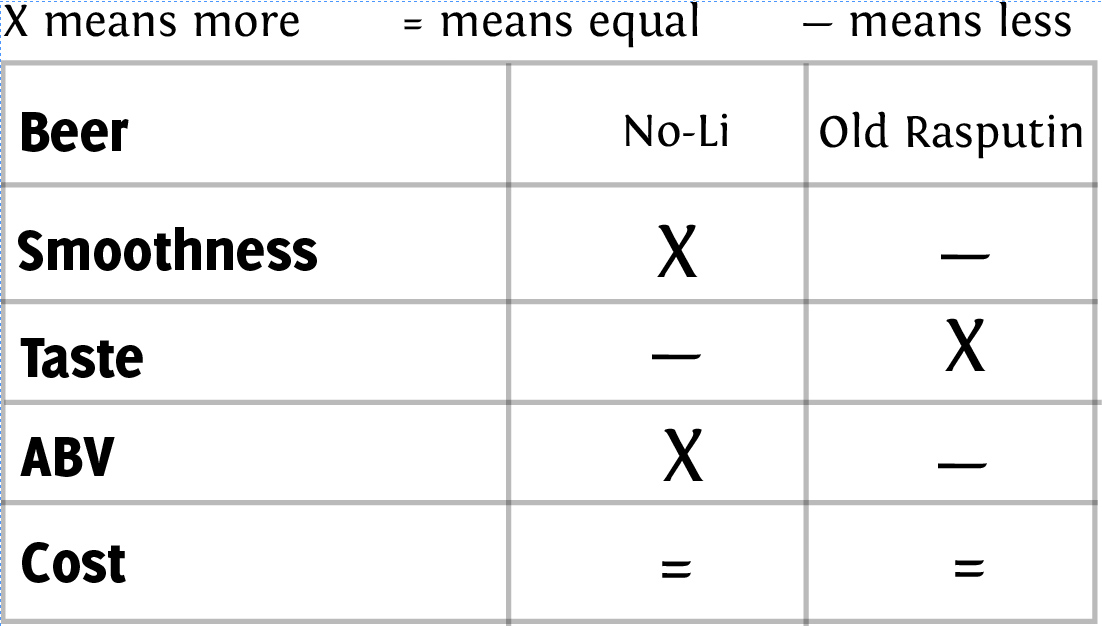Silas Whitley | Crumbs
Beer Comparison
This week I investigated two imperial stouts found at the Moscow Co-op. Those who enjoy stouts know what to expect when drinking one, but if not, stouts are distinguished by a noticeable roasted or almost burnt flavor. This is because recipes generally include a relatively high percent of dark roasted grain compared to other dark beers like porters. Stouts vary widely in alcohol content, from 4 percent alcohol by volume to above 9 percent.
The two stouts were No-Li Imperial Stout out of Spokane, Washington, and Old Rasputin Russian Imperial Stout, from North Coast Brewing Company in Fort Bragg, California. These two beers were the same price ($2.39), which isn’t cheap by any means, but it’s okay to indulge sometimes. The ABV was nearly the same, with the No Li at 9.5 percent alcohol by volume and Old Rasputin at 9 percent.
Each beer had the classic roasted stout flavor, but different balances of other flavors. The No-Li stout had a noticeable alcohol taste and feel, but was still smooth. The taste was somewhat tangy or sour, and was described on the bottle as “fruity.” There was very little head on the beer as well.
The Old Rasputin stout was more subtle in its flavors at first, but opened up to have more depth than the No Li. This stout seemed to have a higher carbonation, so it was less smooth. The beer also had significantly more head than the No-Li.
Overall, I enjoyed the Old Rasputin more than the No-Li. It was more well-rounded and has less of the acridity associated with stouts.
As always, here is a table to help decide future purchases.
Works in progress
This is a new section where I list what I have been brewing and will hopefully inspire some others to try homebrewing.
On tap: Gingerbeer, Red Ale
Bottles: Red Ale, Pecan Red Ale
Primary fermentation: Stout
Secondary fermentation: Nothing
Queue-to-brew: Strawberry Blonde Ale
Homebrewing tips
When mashing during an all grain recipe, the desired range of mash thickness is anywhere from one to two quarts per pound of grain used. The standard I use is 1.33 quarts per pound, unless I’m making a darker beer. When making a darker beer, feel free to use 1.5 to 1.75 quarts per pound of malt. Darker grains make the mash more acidic, so the mash can afford to be thinner.
Mash temperatures for most homebrewers will be between 140 and 160 degrees Fahrenheit. Across this range of temperatures, different enzymes will work to extract fermentable products. Lower temperatures yield more fermentable sugars than higher temperatures in the range. So lighter and dryer beers should be mashed at the lower range between 140 and 149 degrees Fahrenheit. Mash medium bodied beers between 150 and 155 degrees Fahrenheit and thicker beers between 155 and 160 degrees.
For light or dry beers, go no lower than 145 degrees Fahrenheit as mash tuns tend to cool down a little below that. Do not exceed 160 degrees Fahrenheit, as this will end some enzymatic activity and extract tannins, which are bitter like over-steeped tea.
Mash — not mash water — should be around 5.0 or 5.5 pH. Remember that malted grain will decrease the pH of the mash. The acidity of mash can be altered with the use of varying water salts likely found at a homebrew supply shop. Generally, unless a water profile is available or known, not much should be done to tweak mash pH and water salts, because a lot can go wrong. Don’t sweat it. Plain old Moscow water has worked for me in all kinds of beer styles.
Silas Whitley can be reached at [email protected]


